It is a widely accepted fact that straight edge based floor tolerances are outdated and old-fashioned. Still, DIN 18202 continues to be specified on industrial concrete floor projects in most European countries (except for the ones under British influence). Usually DIN 18202 Table 3, Line 3 or Line 4 is part of the floor contract. The truth of the matter is, however, that DIN 18202 floor tolerances are rarely tested for reasons that are very obvious to everyone who ever tried to measure them. Allen Face Europe offers electronic instruments (D-Meter and F-Meter) that make DIN 18202 testing fast and simple.
For more information continue reading or e-mail me at miklos.vass@allenface-europe.com.
Thank you for your interest!
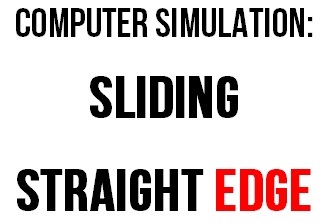
What is DIN 18202 testing like?
All that DIN 18202 testing takes is a floor profiler instrument (D-Meter or F-Meter) and a computer that runs Excel(R) for data analysis.
Let’s suppose that your daily placement is somewhere between 600 and 1600m2. To collect a representative sample of floor profile data, you measure this floor section along two lines in two perpendicular directions parallel to the sides of the floor section. Unfortunately, DIN 18202 doesn’t give any heads-up on the length, number and organization of measurement lines.
Upon laying out the measurement lines, you take your D-Meter and “walk” it along the measurement lines. The D-Meter is a walking type floor profiler. It takes elevation readings every 300mm, thereby shows the floor’s true profile. Generally it takes 30-60 minutes to test a 600-1600m2 floor section with a D-Meter. If you need higher testing efficiency than that, you can use the F-Meter. It is a rolling type floor profiler. The operator pulls it along the lines, stopping every 3m for 2 seconds. The F-Meter allows higher speed testing without compromising accuracy.
The end product of both D-Meter and F-Meter testing is the floor’s profile along the measurement lines, as you can see below.
D-Meter takes readings every 300mm, F-Meter takes readings every 150mm.
THE REST OF THE INTIMIDATING WORK (I.E. DATA ANALYSIS) IS DELEGATED TO THE COMPUTER.
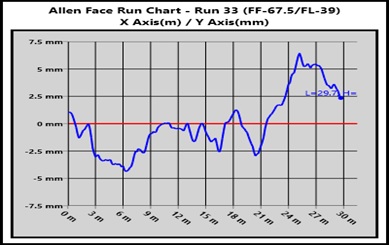
The floor’s true profile along one of the measurement lines (measured with F-Meter)
How is the collected floor profile data analysed?
Once you collected the data, you connect your D-Meter or F-Meter to your computer and download everything via USB.
Then you paste the downloaded data into the complimentary DIN 18202 Analysis Software that comes with every D-Meter and F-Meter and you print the automatically generated test report.
It is very fast and simple and you really wouldn’t have to know more than that. However, I would like to share with you how the DIN 18202 Analysis Software works.
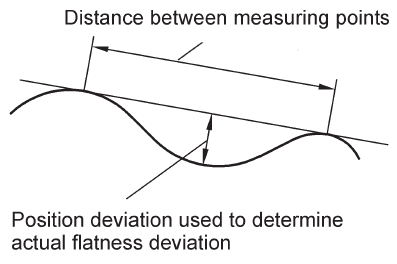
DIN 18202 is not very clear about quite a few things. It provides two methods for floor profile analysis. One of them is taking a straight edge, placing it on the high points of the floor, then measuring the distance between the high points and the gap under the straight edge.
Then you take this information and you go to the graph below.
You find the allowable deviation belonging to the distance between the high points. If the measured gap is smaller than the allowable deviation, it passes the test.
So this is exactly what the DIN 18202 Analysis Software does.
It takes various length straight edges
(D-Meter: 60, 90, 120, 150, 180, 210, 240, 270cm, 3m, 4,5m and 6m)
(F-Meter: 30, 45, 60, 75, 90, 105, 120, 135, 150, 165, 180, 195, 210, 225, 240, 255, 270, 285cm, 3m, 4,5m, 6m)
and slides them through the floor profiles, registers every gap, and compares them to the allowable limit.
In the test report it shows the number of gaps that have been checked and how many of those is deficient.
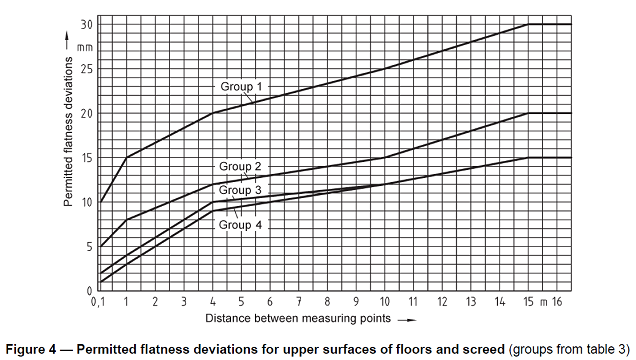
Allowable deviations in DIN 18202:2005
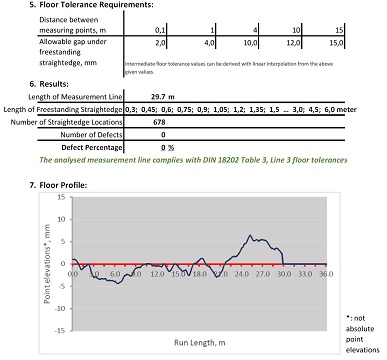
DIN 18202 floor tolerance report
The tolerances of most industrial concrete floors in Europe are specified as DIN 18202 Table 3, Line 3, or Line 4. Our DIN 18202 Analysis Software provides analysis for both Line 3 and Line 4.
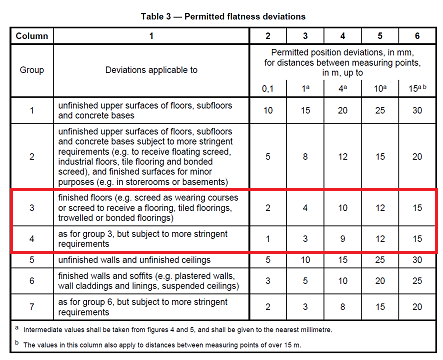
Concluding remarks
D-Meter and F-Meter makes DIN 18202 testing quick and simple. Literally ANYONE can learn how to perform this test.
